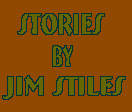

I don't know what made me do it. Some kind of grim, masochistic satisfaction, I suppose. To prove to myself, at least, that it was as bad and weird and crazy as I'd feared. That I hadn't been a lifelong cynic for no damn reason at all. Now I know. Now I know that everything we'd feared was here. And ahead of schedule.
I moved away from the United States in 2006 and relocated on a small island chain in the South Pacific called Funafuti. I was a fool to go there, however, and had already been warned. Global warming and rising sea levels jeopardized the island atoll as far back as 1999. By 2009, much of the island system began to disappear and by 2016, Funafuti was gone. Its inhabitants were allowed to immigrate to New Zealand. I was lucky enough to find a sponsor in Australia and moved to a small town in Western Australia called Boyup Brook, bought a small farm, married a woman of aboriginal descent, and raised sheep until I was almost 80 years old. But recently I'd begun to wonder about America and the place I'd called home for almost 25 years.
I wasn't even sure I'd be allowed to return to Moab. Transportation schedules had become a lot more rigid in the last decade. International flights were exorbitantly expensive and difficult to book. The background/security checks alone required two years and $10,000. And in the U.S. the highway infrastructure of the country had deteriorated badly. The government could simply not keep up with the demand that 400 million citizens placed on it.
It was a strange irony--until the mid-2030s, the cost of oil and its $100/barrel price tag had put a virtual end to leisure driving as we knew it back in the "good old days" of the late 20th Century. How I miss those times and my old GMC pickup.
But the mass introduction of economical, fuel efficient hydrogen-powered "personal transportation vehicles" (PTVs) returned Americans to the road, en masse. It had often been said that oil was too precious to burn---suddenly the precious Black Gold was available in massive surpluses and the price plummeted. All that oil could now be used in the manufacture of synthetic materials and the never ending development of new products to keep the growth economy growing.
Free from mandatory conservation measures that had slowly turned Americans toward a simpler and less material life, now the country and much of the world embarked on a spending spree of an unheard of magnitude. It made the 1990s look like the Great Depression of the 1930s. With inexpensive transportation and cheap oil, the cost of living in most respects plummeted as well.
But the impact on the nation's highway system was staggering; while buying and maintaining a PTV was inexpensive, the cost of using the roads became exorbitant.
And so the government was faced with some options: It could raise taxes to levels sure to trigger a major downturn in this booming economy. Or it could restrict use and hope to extend the lifetime of the rapidly crumbling Interstate System.
I spent a small fortune on my flight, applied for a U.S. domestic travel visa and hoped for the best, but without much hope. Even if I was given a visa, I was in no condition to drive. I had to give it up years ago, not because I'd lost my driving edge, but because I could never grasp the new technology. I liked using a steering wheel and pointing the vehicle where I wanted it to go. These auto-lane sensors were an annoyance to me and I kept trying to override the system. I may be pushing 90, but I didn't need some damn computer system to tell me where to go
My travel prospects looked bleak. Then, and this is how much of my life has been, coincidence and good luck changed my fortunes.
A few weeks ago, out of the ether came a faintly familiar sound. The caller had put an electronic block on the video transmission, but the voice and the words shook long-forgotten memories from remote corners of my brain...
"Jim Stiles! It's your good friend Rich Ingebretsen!"
I stared at the static on the monitor. My hands began to tremble. "Jesus Christ," I muttered.
"No...I'm still a Latter Day Saint, but haven't ascended to that level yet."
"I can't believe it....How are you Rich?"
"Still waiting to see them drain the lake."
"I heard you'd come close."
"I'll tell you all about it."
Dr. Ingebretsen had done well for himself in the past half century. A physician by trade and a tireless proponent of the movement to drain the Powell Reservoir in the last days 20th century, Ingebretsen had done much to legitimize the issue and his reasonable approach to many environmental issues thrust him into politics. In 2018, he was elected lieutenant governor of Utah.
So it was arranged that he and his wife Nadine would pick me up at the jetport and that we'd travel by Interstate 10 to Phoenix, then north on I-17 all the way to Moab, Utah.
"There's an interstate highway in Moab?"
"Been there since 2025."
With lane sensors, the drive was effortless, although the traffic was insane. Even with driving restrictions, cars and trucks were bumper-to-bumper and moving at 80 mph. We by-passed Phoenix and Flagstaff during the long night drive, but I considered a side-trip to the South Rim.
"Can't do it," Ingebretsen advised. "Not unless you made a reservation four to six years ago.
"Four to six years? That's impossible."
Rich just chuckled. "You're in for a shock, my friend...it's going to get worse." He explained that all national parks in the U.S. system required advanced booking. Every morning, at dawn, hundreds of permit-less travelers waited at a huge reserve parking lot near Cameron, Arizona and waited for the 7 am lottery numbers to be called. An extra 50 permits were provided each day for a handful of lucky and persistent Grand Canyon aficionados.
"I've never won anything in my life...I guess stopping would be a waste of time."
"I guarantee it," Ingebretsen said. "Keep going driver."
We hurtled north through Monument Valley at sunrise and into Utah. The scenery looked the same, or what I could see of it, but the long vistas were long gone."
"What is this haze? Is there a forest fire?" I asked.
"Stiles, you've been gone too long. This is 'Blade Runner' come to life. Remember the old movie with that actor? What was his name?"
"Harrison Ford?"
"Yeah...the guy who became governor of Wyoming. THIS is the way it is. The crap blowing in from California, from Phoenix, Las Vegas, St. George, Salt Lake...it's brown sky by day and orange sky by night."
Old highway 191 was gone--swallowed by the interstate. At Devils Canyon, I glanced over my shoulder, then turned away. I didn't want to know. Hole "n" the Rock, was now on a freeway off ramp, but what shocked me more was the exit ramp sign: "South Moab." According to the Fodor's Guide in Ingebretsen's PTV-GT, Moab's population had recently passed 60,000, more than double what build-out studies in the 1990s calculated the valley could handle.
And sure enough, the growth had spilled over Blue Hill and even beyond the now defunct tourist attraction (I learned that Chinese investors bought Christensen's sandstone home in 2027 and now use it as a private vacation resort for many of its high-level executives.
Finally, we descended Blue Hill and into "town," 13 miles south of the old city limit. In 2037, Grand County finally annexed a 35 square mile segment of neighboring San Juan County and a year later, after almost a century of debate, the county and city governments consolidated. The vote was close and many of the "old Moabites" were furious. In the early days of the 21st century, after the passage of an "anti-junk ordinance" many of Moab's residents had moved across the county line where building codes and land ordinances were less strict. With consolidation, the city moved to condemn and remove many of the residents and their modular homes, trailers and vehicles. They had all sought refuge in San Juan County and now they faced an uncertain future. The old owners could derive some comfort from the price their land brought (A five acre ranchette lot with water and power sold for about a million dollars.), but for many the money meant nothing. There was no place else to go.
Many of the old homes in Moab were gone--torn down to make room for more high-density housing developments. I tried to find my old house on Locust Lane, but couldn't even find the street, much less the structure. Incredibly, Dave's Corner Market was still standing at the corner of 4th East and Mill Creek Drive, but was now called Maynard's & Maynard's and featured optional "nude shopping."
Downtown was unrecognizable. Most of the old buildings were gone; of course, there weren't all that many old buildings left in 2000--Moabites never did have much use for leaving things alone. Much of the valley was covered with ten to twenty story condo developments. Something had been needed to handle the swelling throngs of emigrants from the big cities.
I was determined to find some of my old camping spots and spend the night under the few remaining stars that could pierce the haze. We headed north toward Arches and Ingebretsen started to remind me...
"I told you before...no reservation, no entry to the parks!"
"I know Rich. I'm not headed for Arches. I want to take that old jeep road by Dalton Wells. I've got to get away from all this."
"Stiles...you just don't get it. You can't...can NOT get off this road. This vehicle is programmed to go where we're allowed to go. All that public land out there is closed, just like the parks. The wilderness zones. All of it. There's a waiting list three years long, just to do an overnight at the Dalton Wells Camping Area. Of course there's a Marriot at Dalton...$425 double occupancy."
I stared blankly out the window. "Somehow I never dreamed it would be THIS bad...what's it like in Thompson?
"Don't ask."
Hopeless. We were able to program the vehicle for a return trajectory and back to Moab. As we returned to town via the bypass, I could see Charlie Steen's cliffside home high above the valley on what used to be Moab's north end. The 1950s mansion of the Uranium King, bathed in colored spotlights, was clearly visible in the early evening sky.
"Hey," I wondered, "Do the Steens still own Mi Vida?"
"It's in litigation," Rich said. "The youngest son, Mark, finally gained custody of the home and for a while, he apparently tried to restore some of the ambience and excitement of the Boom Days. But..."
"What?"
"Well...one night he tried to recreate one of Charlie's great parties. Invited about 500 guests to the hilltop mansion. Everyone had a to dress 1950s-style and the folks were all having a wonderful time. But then Mark, who was about twelve sheets to a strong breeze, fell off the railing and cracked his head. He was 73."
"Damn...he always was sort of crazy."
"But it was a nice gesture."
As we passed the north "Moab Portal," a massive fake adobe and pine log entry, I thought about Abbey and Sleight. Just north of what used to be Moab's city limit, we passed the Moab Springs Condos. It was once a restaurant and we called it the Grand Old Ranch House, and before that, when my old buddy Treadway lived there in the off-season, it was just the ranch house. I'd met Abbey in the front room of that old building. I gave him a drawing of Glen Canyon Dam blown up. Just beyond Chi Chi's chain Mexican restaurant (formerly La Hacienda), Ken Sleight owned a little book store; I remembered the day we celebrated Ed's new novel The Monkey Wrench Gang.
"How's the environmental movement going these days?" I asked. "As if it mattered."
"As if..." Rich sighed. "Well...they finally got what they wanted. The Drought did most of the ranchers in and big city speculators snatched up most of the land. Remember Escalante? It's got a population of 15,000 now. They have their own Classical Music Festival and I hear they've got the highest median income in Utah except for Park City and Panguitch.
"What about a wilderness bill?"
"The Congress passed the "Red Rocks Wilderness Bill" in 2020. That Sierra Club and...what was the other one? SUWER?"
"SUWA."
"Yeah...SUWA. They got their 9 million acres or whatever it was. But with so many people moving here and with the increased travel, the easily accessible wilderness areas got slammed. Unbelievable damage from millions of morons. Finally the government allowed the construction of designated trails inside the wilderness areas and restricted private use to those routes."
"Some wilderness."
"Yeah, but it gets worse. The enviro groups and the recreational industry got together and proposed that most wilderness travel be restricted to commercial use. The industry sold the enviros on the idea that they could control impacts and limit abuse much better than letting these yahoos wander about on their own."
"There are a lot of yahoos these days."
"Better a yahoo than a lemming."
"So today, if you want to take a hike up Courthouse Wash, for example, you can wait for a permit, or we can sign you up right now for one of the senior tours. These companies have covered every angle. They've got a package for every demographic. If you've got the money, they've got the tour."
"I feel sick."
"Hey...not to despair. They're all 'proud members of the Utah Wildlands Allegiance.'" All the groups consolidated in 2025, in conjunction with the Outdoor Products Environmental Esprit (OPEE). Remember...they were your pals."
"If you recall, I moved to the South Pacific."
I could feel my metabolism rising again, the old ticker. I reached into my shirt pocket and popped a couple of little blue pills. "So tell me, is there any resistance to any of this? Is there any youth uprising against all these restrictions and controls? This total sell-out?"
Ingebretsen shrugged. "Look...none of these kids even remembers what it was like to have freedom. Even 40 years ago, you could see that. After that War on Terror, remember what happened?"
"The 'War on Terror,'" I sighed. "When will it end?"
Dr. Rich glanced at me with an unfamiliar look of concern. "Hey, there is one good bit of news. We almost drained the reservoir."
I laughed bitterly. "What is they say? Almost only counts in horseshoes and hand grenades?"
"Well. The water needs of the southwest became so acute that by 2030, the value of a gallon of water far exceeded the electrical energy that the dam produced, especially after the ion engine was developed. Downstream in California and Arizona, they needed the water there, not in the middle of Utah. But all the growing little towns on the Colorado Plateau wanted some of it as well. It was weird. Here was the Utah Chapter of the Sierra Club arguing in favor of a pipeline to Escalante and Panguitch and Kanab, when they'd opposed the St. George deal back in '99. Finally the enviros and the watermongers reached a compromise. The dam would stay but they'd draw down the level of the reservoir by 300 feet. It opened up a lot of the upper parts of Glen Canyon...we got Cathedral back. But Music Temple is still under 250 feet of water. And of course, like everything else, the waiting list to float down the re-exposed parts of the river is several years long. The best way to see it is to volunteer for the restoration project--it's quite an undertaking."
We drove to the south end of what used to be Spanish Valley again, mostly in silence. But we were using up our surplus of urban miles and needed to find a place to sleep.
"Damnit, Rich. I refuse to go to a hotel. I want to camp out. Just let me out here and I'll take my chances. Pick me up right here tomorrow morning at 7 am."
"You're crazy. For one thing, you're almost 90 years old. You look like hell. I doubt if you'd get 100 meters. And second it's illegal. They have sensors along this road. A security patrol would be here in ten minutes."
"I don't care. Stop the car."
Ingebretsen's driver slowed and pulled to the shoulder of the road. I pushed open the door and stared into the hot late afternoon sun. In an hour the light would fade behind the great ramparts of the West Wall. I had often thought of exploring all those cracks and crevices and broken canyons. Each time I drove south in my GMC truck, I'd stare longingly at those mysteriously beautiful, harsh yet inviting towers, and somehow, I'd never stopped. Now I would.
"Are you sure..."
"See you in the morning, Rich."
I stepped over the Russian Thistle that still grew prolifically along the Interstate and slid down the embankment. With great difficulty I climbed the three-strand fence and tore my old jeans in the process. Damn. I'd had those Levis for 45 years.
The roar of traffic behind me was inescapable but I ignored it. Put it away in some other part of my brain. This is why I came. I saw an old juniper tree, its weathered silver trunk caught in the late sun, each swirl of bark and wood delineated and accentuated by the light. A bird...I looked closer. A Say's Phoebe landed on one of the skeletal branches just above my head. I listened. Her song was as melancholy and sad as the first time I'd heard her, 60 years earlier. I began to weep. An ant crawled up my pant leg and bit me on the calf. It felt good. I took off my boots and dug my wrinkled and withered old feet into the hot red sand. I leaned against the juniper's trunk and looked up. Above the burnt green berries and the foliage and the phoebe and the streaked canyon walls, I could still see what was left of a desert sky. I could almost see stars.
In the distance, from the north, the sound of sirens grew louder and louder.







